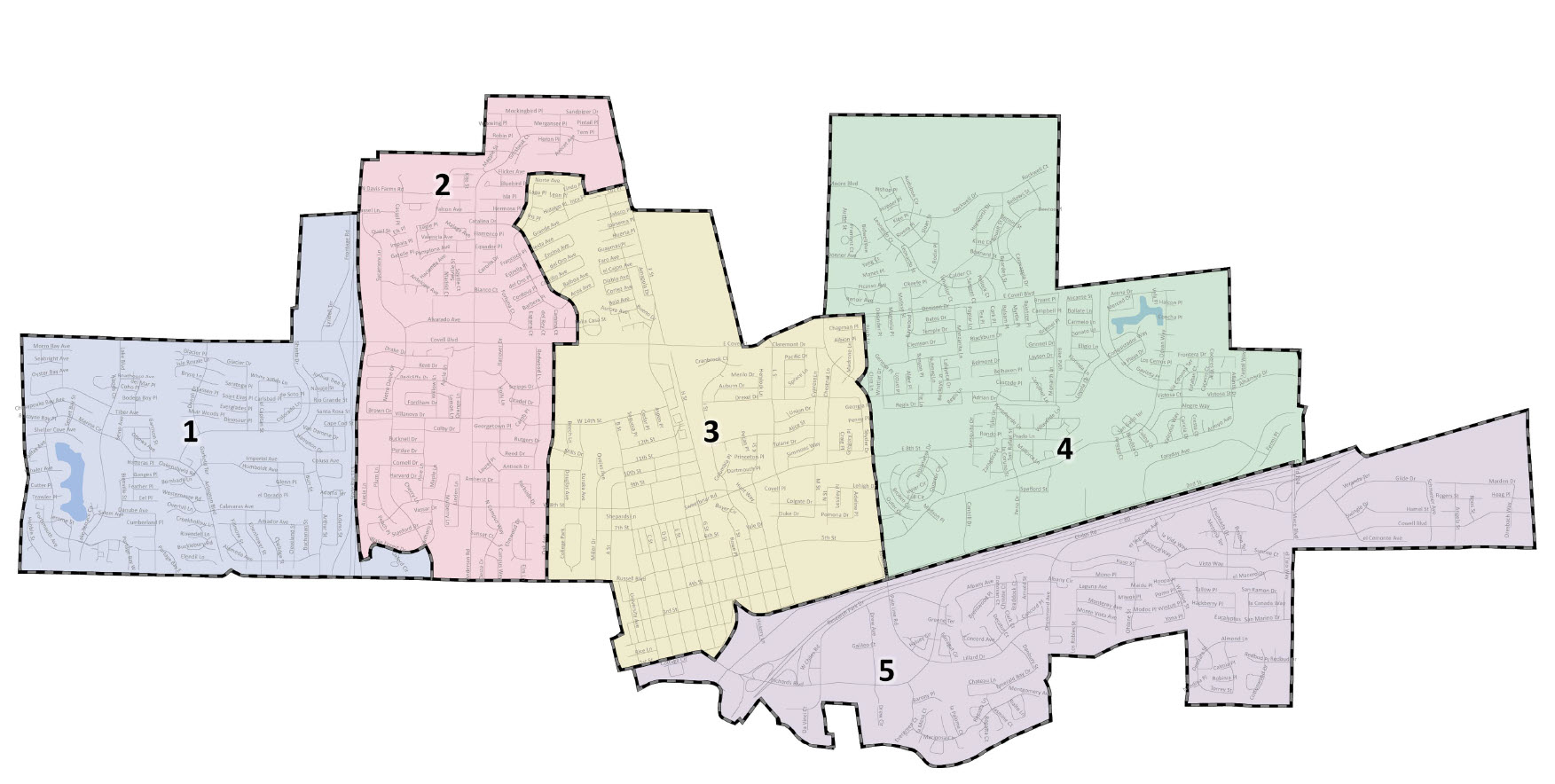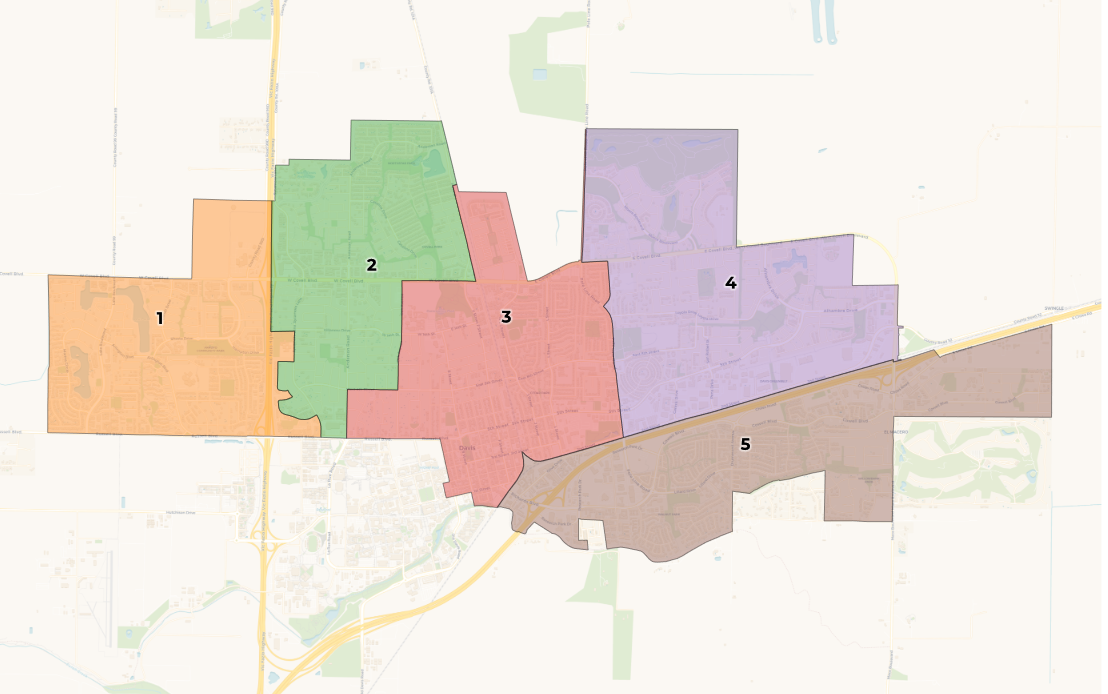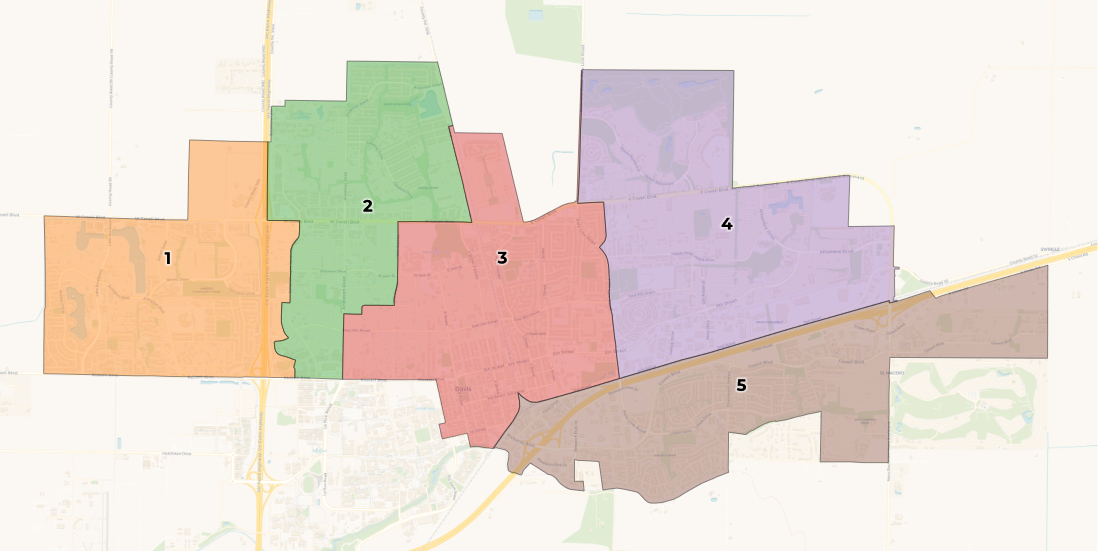

By David M. Greenwald
Executive Editor
Davis, CA – When former County Supervisor Matt Rexroad threatened to sue the city of Davis, probably on behalf of his client, the Davis College Republicans, forcing the city to go to district elections, I was one of the few who looked at the prospect favorably. I have since changed my mind and see that the downsides far outweigh the benefits.
If you want ensure that people of color do not get elected in a city like Davis, create a series of single-member, winner-takes-all-districts where the minority population never exceeds forty percent. Unlike cities like Woodland and West Sacramento, Davis is relatively homogenous, with communities of color distributed relatively evenly throughout. There are not enclaves like you see in other communities.
Under the previous system, the voters would get to select their top two or three choices. In a big field, someone could win with a relatively low percentage of the total vote. Now the only way to get on the council is to finish first in your district. That’s not conducive to people of color winning in a city where the majorities of voters in the districts are white.
In short, what worked well in Woodland to get people of color on their council does not work in Davis.
What options do we have at this point? Well, the city could still challenge in court whether it has to go to district elections and it could present the notion that it makes it less, not more likely, to elect people of color. It could also opt for choice voting as a means to get away from a single-member, winner-takes-all mentality.
In the meantime, the redistricting process in an exercise in absurdity.

 Meet the new maps… same as the old maps.
Meet the new maps… same as the old maps.
Okay, close but not quite. Not only are the two maps remarkably similar though not identical to the final 2020 district maps, they are even more closely resembling themselves.
This might be wickedly funny, except of course for the fact that we actually paid money (really twice) for the demographics people to help draw these lines. And then we are filling up staff and public time to get input.
The two new maps are even more closely resembling each other than they do the 2020 map. But most of the maps are the same. It is interesting that they went for the same basic configuration as 2020. That means there is basically one district in South Davis. The only difference is how far it extends to the west into the core area just north of I-80.
District 4 is identical in all three maps. District 3 – which could be vacated by Lucas Frerichs if he becomes supervisor, is slightly different along the western boundaries, both from the 2020 map and each other. District 2 is the most different from the 2020 map, but the two options are fairly similar, with slightly different boundaries on the east, and the southwest.
One is slightly different, as it extends more to the east than previously, with only slight variations.
Unless there is a weird cut or some awkward boundary, the two maps are not going to generate much attention from the public.
But, hey, we have to have a public process to determine that the new maps are the same as the old maps and not likely to change much in town and certainly no more likely than before to generate people of color—not that that’s probably that foremost in the council’s mind at this point.
I suppose there is one more option—we could try something radical and go to seven or nine districts rather than five. That might make it possible to get some students elected to council. It also might make it more likely to get people of color elected to council.
Other than that, this is largely a status quo map, not likely to shake up the make-up of the council. You would think if we were paying for this, the council could at least give us some different looks—it’s not like there are none. We had some very different configurations last time, including parts of two districts in South Davis.







Isn’t that a good thing?
Is getting people of color elected the only goal? Shouldn’t electing the brightest and best candidates be the goal?
But you stated Davis shouldn’t fight because “it is unlikely that we will win, it is costly, and at the core it is probably not the right thing to do anyway” and “risking $4 million and counting on a legal fight that we likely cannot win”.
Has it occurred to you that those lines might be the best fit with what the analysts were working with?
“Isn’t that a good thing?”
Doesn’t matter if it’s good or bad, it is the state of being and precludes the remedy that district elections bring.
“Is getting people of color elected the only goal? ”
That was the point of the CVRA to give people of color who are underrepresented a fair shot at representation. That was the ostensible reason listed in the letter to the city. So if the remedy doesn’t work, then you have a problem.
So are you inferring that the people of Davis, which is very progressive/liberal and votes @80% for Democrats, cast their votes according to the color of the candidates instead of their qualifications?
And vice versa, are you inferring that people of color cast their votes for other people of color instead of a candidate’s qualifications?
What I’m saying is that the law, CVRA was put in place to fix specific problems that not only were not fixed by the prescribed changes in Davis, but were exacerbated.
Does the fact that the new law doesn’t fix a specific (perceived?) problem out weigh the possible benefit that the new law/system would provide more direct voter connection to their representatives (through regional vote and representation)? I’m asking…as I haven’t really thought or researched this too deeply.
Shouldn’t my input/vote/connection with my council person/representative be more significant than someone on the other side of town? Let’s take DISC for example. I’ve said for months that the only way something is going to get approved in Davis is for all of the rest of Davis to out vote one region. In DISC’s case it’s East Davis and possibly part of South Davis. So the voters and the rest of the council are going to have essentially say “suck it up and take one for the team” in terms of traffic..etc… But maybe East Davis and South Davis can band together and maybe get one more vote? But under the previous system; even though you have regional representatives, they also represent the greater will of the larger voter base. I will once again reference Robb Davis’ comment from a couple months ago where he said he represented all of Davis’ interests when voting on projects. Now he meant that in the role as Mayor. But to lesser but still significant degree that would apply to the other council members as well as they are voted in by the greater Davis electorate.
“Does the fact that the new law doesn’t fix a specific (perceived?) problem out weigh the possible benefit that the new law/system would provide more direct voter connection to their representatives (through regional vote and representation)? I’m asking…as I haven’t really thought or researched this too deeply.”
That would be up to an individual’s calculation, but if the law is designed for a specific purpose – it works for that purpose in some communities but not others, that suggests rethinking the rationale for the change.
That’s my point. Maybe the law has more than one purpose. It’s effects go beyond what some Republican group intended it to be.
I disagree, the CVRA was specifically written to “prohibits an at-large election system from being applied in a way that impairs the ability of a protected class to elect candidates of its choice or influence the outcome of elections because of the dilution or abridgment of the rights of the voters who are members of the protected class.”
And the specific remedy is district elections, there really is no other purpose for the law.
What exactly are you disagreeing with? I never stated a disagreement with your comments about the perceived assault on the “protected classes”. I’m less concerned or focused on it than you but I don’t completely disagree with it in theory. Yes, I suppose because of the heterogenous geographical distribution of race in Davis that a diluting of racial representation is one result….on the other hand everybody’s vote still counts the same regardless of race. But you seem stuck and fixated on this one aspect simply because a bunch of Republicans intended the change in the law for that reason.
What I’m saying is that the change in the law does more; it provides a possible benefit. It can possibly provide better and more direct regional representation.
This is exactly what SB 9 and SB 10 are all about. Streamlining the process to build more affordable housing in order to integrate communities with more people of color and those of lesser means.
So now this is a problem because district maps can’t be manipulated in order to try to get people of color elected?
Neither of those bills are directly about affordable housing. 9 is about splitting lots and building duplexes. That’s more housing but not affordable housing. 10 is about streamlining approval for 10+ units. Again more housing but not affordable housing. Maybe since it’s not single family residential housing it’s …less expensive housing? I think you may be thinking of SB 35 which streamlines (goes around the YIMBY’s) affordable housing developments.
Edit: I think you may be thinking of SB 35 which streamlines (goes around the NIMBYs) affordable housing developments.
Caving to Rexroad was a mistake. Santa Monica fought and won, and the appellate court confirmed this. We may be waiting on the State Supreme Court, but the decision looks strong. The burden of proof would be on Rexroad to show that going to districts would result in a discernable difference. Santa Monica has at least one neighborhood of a disadvantaged community and the proponents could make their case.
“The burden of proof would be on Rexroad to show that going to districts would result in a discernable difference.”
From the city’s memo:
“The threshold required for showing a violation of the CVRA is low. For example, a minority group does not have to be geographically compact or concentrated to allege a violation of the CVRA. Finally, proof of intent on the part of the voters or elected officials to discriminate against a protected class is not required. The main remedy under the CVRA is to move to district-based elections, which is a method of election in which “the candidate must reside within an election district . . . and is elected only by voters residing within that election district.”
The City solicited comments on the new maps, and I sent the following comment to them.
.
There is a definite community of interest in Davis that the draft district maps do not specifically call out and address … the UCD student population. To a lesser extent all the retirees in Davis are also a community of interest that is not being addressed.
The differences between Map A and Map B in how they deal with those student voices may be significant … especially in District 1.
Annex U.C.D. !
Exactly. The real lack of representation is for students. First, they are disenfranchised by not annexing UCD and second they are disenfranchised by these maps. If you were to draw a district that wraps around UCD you might be able to get a student elected to the CC more than once a century.
If the intent of having a council is to represent potentially different population groups, the election method should be based on endorsement:
Each voter has one ticket to endorse one candidate regardless how many people will be in the council.
A candidate is elected if it has enough endorsements (which should be slightly less than 1/5 endorsements of all voting participants if there are five members in the council).
While elected, a voter may withdraw their endorsement. When an elected member’s endorsement drops below a threshold, the member is considered recalled.
With an endorsement method there is no need to set districts. There is no pressure for a person to move to another district to get a better chance to be represented.
(Districted election creates a segregation force. A minority of 49% in each district will have 0% representation when they should have 49% representation.)
Zone 5 resembles an AR 15. Maybe that’s grounds for a challenge?